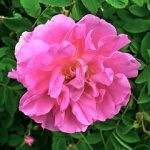
Damask Rose
Do you have a history with rose?
My own history with rose fragrance as a child was that my grandmother used rose milk lotion. Unfortunately, a quick check to the Environmental Working Group, which lists products and their chemical content (in a health hazard measurement system), indicates that synthetic Rose Milk lotion is not healthy. Still, I associate the smell of rose with my grandmother, and that is a nice memory.
The Nose Knows
Tests demonstrate that Rose is one of the most recognizable fragrances in the world, second only to clove. (The Rose, 336). While Turkey produces the most rose oil, Bulgaria earns the highest prices for its rose essential oils, because they are regarded as the highest quality (The Rose, 358). Regardless of where grown, rose oil is expensive! A 30ml bottle of unadulterated, pure, high-quality rose essential oil will easily set you back $200.
Wild and Humble Beginnings
Where did the rose begin its life? Fossil evidence for wild roses points to China and to North America (The Rose, 4). Roses may also have come from Crete and Persia, but determining their exact first location has been difficult for researchers.
A Global and Heavy Load of Symbolism
The first recorded writings about the Rose were by Sappho which catapulted us all toward a romantic link between the Rose and love. (The Rose: An Illustrated History, 11). We have applied the quality of love to just about everything rose-like. For example, in the study of crystals, rose quartz is a gemstone of unconditional love, releasing trauma and the heart chakra, among others (The Encyclopedia of Crystals, 22).
From being used as a Christian symbol of paradise to the United States political seal for the White House, the Rose has had its day in the limelight in many cultures since pagan times. In Christian history the Rose came to represent Paradise (The Rose, 75-77).
In art we see the Madonna and child paintings, which have the pair supported by cascading roses; in literature the use of the Rose in the Dante’s The Divine Comedy; and the Rose became a symbol for feminine sexuality. (The Rose, 103-104). The Rose image has been used for royalty, royal family, politics, battles, Washington politics, and more (The Rose, 263).
Rose As Medicine
As far back as 79 AD, the Greek physician and botanist Dioscorides describes Rose as being used for a variety of ills, such as inflammation, pain, sore eyes and ears, gynecological issues, intestinal issues, and more. He describes Rose as having astringent qualities. (The Rose, 295-297). Some aromatherapists believe that Rose is best suited only for fragrance in perfumes, due to its high cost. (Advanced Aromatherapy, 87). Others think that Rose has a special place in skincare for mature skin, scars, and wrinkles, and its other uses can be for emotional balancing, anxiety, depression, and as an aphrodisiac. (Aromatherapy, 148).
In your aromatherapy journey, you might encounter Rose Absolute and Rose Otto (or Rose Essential Oil) — what is the difference between the two? Rose Absolute is distilled via solvents, has a stronger odor, and is typically used in perfumes. Rose Essential Oil is from steam distillation and is more difficult and costly to make, hence the price difference in the two. (The Essential Oil Handbook, 266-269).
Try It Yourself
How can you use Rose essential oil in a blend? You can use an inhaler with Rose essential oil, or try it in a muscle rub or massage oil.
- (in 2 tbsp of carrier oil such as jojoba)
- 1 drop Rose essential oil
- 1 drop Frankincense
- 1 drop Roman Chamomile
Sources: Potter, Jennifer. (2010). The Rose, Great Britain: Callisto and Atlantic Books. pp. 4, 75-77, 103-104, 263, 295-297, 336, 358; Harkness, Peter. (2003). The Rose, An Illustrated History, New York: Firefly Books. pp. 11, 243; Harding, J. (2010). The Essential Oils Handbook, New York, NY: Sterling Publishing Co., Inc. pp. 266-269; Schnaubelt, K., PhD. (1995). Advanced Aromatherapy, Rochester, VT: Healing Arts Press. pp. 87; Harrison, Jimm. (2008). Aromatherapy, Therapeutic Use of Essential Oils for Esthetics, New York: Milady. pp. 148; Hall, Judy. (2006). The Encyclopedia of Crystals, Boston, MA: Octopus Publishing Group. pp. 22.
Image: photo of Rosa x damascena by H. Zell / CC-BY-SA-3.0
Articles copyright of Rebecca Mitchell-Guthrie and not to be reprinted without permission.
The information presented on this site is not intended to diagnose health problems or to take the place of professional medical care. The information contained therein is neither intended to dictate what constitutes reasonable, appropriate, or best care for any given health issue, nor is it intended to be used as a substitute for the independent judgment of a physician for any given health issue. All content, including text, graphics, images and information, contained on or available through my web site is for general information purposes only.
